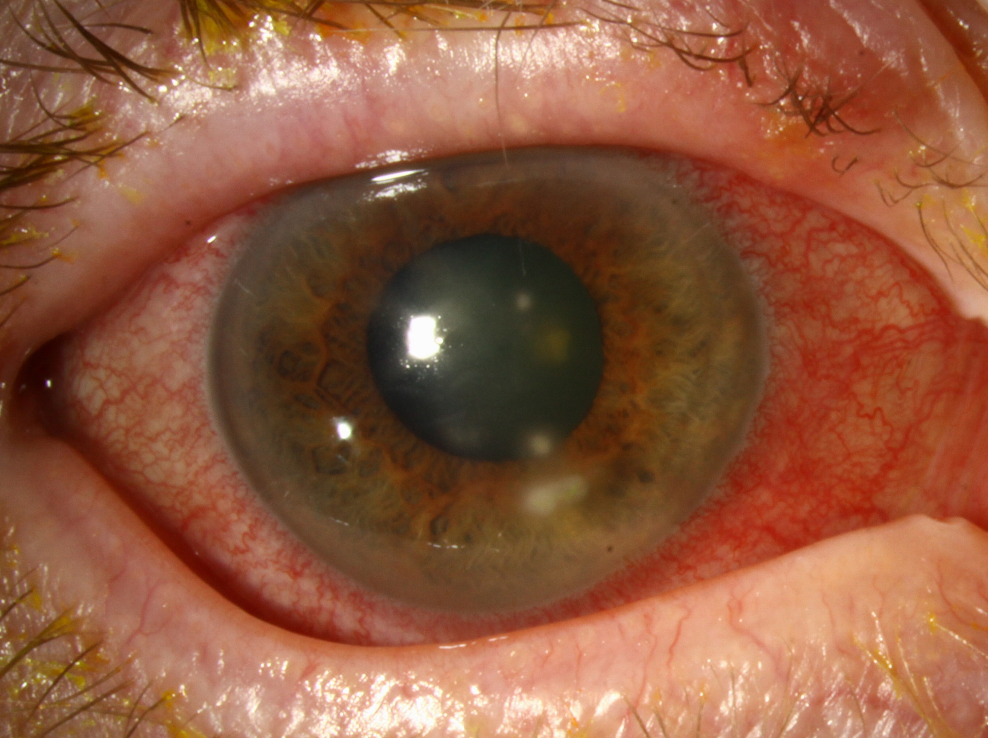 |
| Complete corneal healing after using PACK-CXL was reported in the second month postoperatively in 90% of eyes. Photo: Christine Sindt, OD. Click image to enlarge. |
A concern in infectious keratitis management is multi-resistant bacterial strains. If your first-line antibiotic drug isn’t effective, most clinicians would add another to increase the chances of halting ulcer progression during a critical period. Of course, this potential overexposure of antibiotic agents to the microbial world increases drug resistance. An interesting non-pharmacological approach relies on the antimicrobial effect of riboflavin photo-activation, known better for its role in collagen crosslinking (CXL) to treat corneal ectasia in keratoconus patients.
Researchers in Egypt recently evaluated the safety and efficacy of repeated sessions of photo-activated chromophore for keratitis crosslinking (PACK-CXL) for the treatment of resistant bacterial keratitis. They determined that this procedure could overcome the antibiotic resistance that has become rapidly spreading worldwide. Repeated sessions of PACK-CXL may be more effective for the treatment of resistant bacterial keratitis until complete epithelialization and resolution of bacterial keratitis than a single session with little complications, they concluded.
This retrospective clinical cohort study recruited 30 patients with clinically suspected and lab-confirmed bacterial keratitis resistant to appropriate antibiotic therapy. They were 16 males and 14 females, with a mean age of 44.3. The mean ulcer size was 3.96mm3, while the mean size of stromal infiltrates was 4.52mm3. On presentation, visual acuity of > 6/60 was reported in six patients, 15 patients had visual acuity of < 6/60 up to counting fingers and nine patients had visual acuity of hand movement. CXL window absorption involves gently swiping the center of the ulcer to remove all cellular debris without completely de-epithelizing the cornea, creating a window for hypo-osmolar riboflavin installation (absorption) and radiation. The antibacterial properties of CXL are a result of UV light’s interaction with the chromophore riboflavin.
Successful treatment was reported in 12 eyes (40%), 10 eyes (33.3%), five eyes (16.7%), while failure was observed in 18 eye (60%), eight eyes (26.7%) and three eyes (10%) after two, three and four sessions, respectively. The overall success rate was 90% after the repetition of four sessions of PACK-CXL window absorption one week apart, while the overall failure rate was 10% after four sessions of PACK-CXL window absorption one week apart.
In the three eyes that were resistant to the four sessions with delayed epithelialization, amniotic membrane grafting was performed, together with antibacterial therapy until complete healing and corneal vascularization was attained.
The mean ulcer size decreased from 3.96 mm3 after two sessions to 2.18 mm3 and 0.57 mm3 after three and four sessions, respectively. The infiltrate size had a mean of 4.52 mm3 after two sessions and decreased to 3.16mm3 and 1.93 mm3 after three and four sessions, respectively. The response was found to be much better in gram-positive bacterial keratitis (24 eyes) than gram-negative bacterial keratitis (two eyes) or mycobacterial keratitis (one eye).
The researchers proposed the postulated mechanisms that may illustrate the role of repeated sessions of PACK-CXL window absorption for treating resistant cases of bacterial keratitis may be summarized in two main actions: bacterial eradication by damaging bacterial DNA and RNA (especially of the antibacterial-resistant strains), together with, enhancement of epithelial healing through stromal collagen enhancement and Bowman’s membrane stabilization.
“PACK-CXL may be a promising new alternative and its use is recommended due to the potential benefit obtained by controlling infection regardless of drug resistance, stopping the melting process, avoiding emergency keratoplasty, decreasing the possibility of performing lamellar grafts for visual rehabilitations and decreasing rate of corneal graft rejection due to its role in suppressing corneal vascularization,” they wrote in their paper.
Nevertheless, they concluded that further prospective and comparative studies are needed to support the results.
Tawfeek MMM, Ahmed HMAHM, Bor’i A, et al. Repeated sessions of PACK-CXL WA for the treatment of resistant bacterial keratitis: a retrospective study. BMC Ophthalmol. July 26, 2023. [Epub ahead of print]. |

